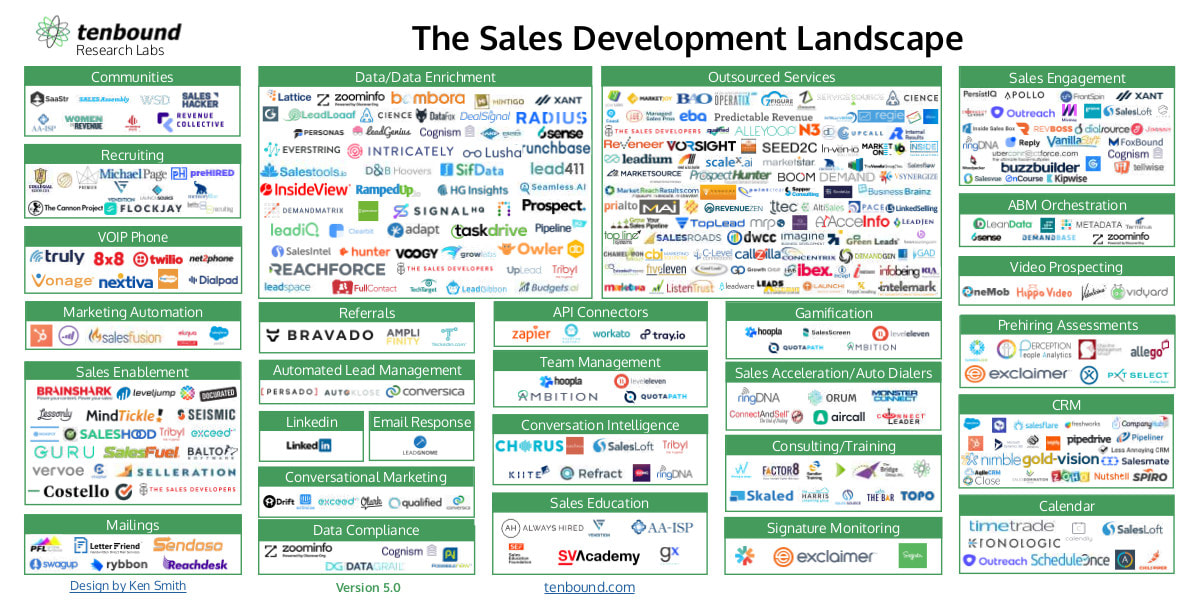Recruiting and Retaining a Top Sales Development Team, with Daniel DeFilippo of Mimeo
3/31/2020
Comments
Daniel DeFilippo started out as a public accountant. However, he soon found himself bored out of his mind. The breaking point came when he fell asleep at work and a highlighter bled through 400 pages of inventory. He made the jump to sales, where he’s thrived and built an impressive resume.
Now he’s Director of US Sales Development at Mimeo, where he loves helping people and seeing junior reps grow into polished, solution-oriented sellers: “There's nothing better for me... That's what gets me out of bed every day.” He sat down with the Tenbound team to discuss recruitment, outdated tech features, and his philosophy for creating a top-performing Sales Development team. Challenges in Sales DevelopmentFor Daniel, the biggest challenge he faces is finding and retaining talent. However, he’s found that talking about a career progression plan from the very first interview helps retain that talent. There's a common misperception in Sales Development that SDRs are just feeding the sales funnel. The real value of an SDR team is creating and molding your next class of AEs or CSMs. Lauren didn’t have a traditional start in Sales Development; After studying molecular biology and theology, she spent four years researching termites. However, meeting some sales professionals on a trip to San Francisco changed her life.
Starting out as an SDR, she has worked her way up to Head of Global Sales Development at Segment. In our interview, she discussed the importance of personalization, how her background has helped her, and her goals for 2020. The importance of personalizationWhen Lauren started her first SDR role, her team was sending 100% automated emails with zero personalization. However, she started attending conferences where speakers like Ralph Barsi, Steli Efti, and Sean Sheppard were talking all about the importance of personalization. After eventually convincing her boss to let her try some personalized outreach, she booked three times as many meetings in her second month than any SDR at the company had before. After graduating, Robert decided to go into Sales; a good fit as he enjoys meeting and talking to new people. Following the advice of his family and mentors, he combined this with his love of technology and went into software sales.
Since then he’s worked his way up the ranks at companies like Outreach, before becoming Senior Director of Inside Sales at AuditBoard—#3 on the Deloitte Technology Fast 500. He sat down with us to discuss the Sales Development challenges they face, creating the best possible tech stack, and their plans for growth in 2020. Building a strong Sales Development teamFor Robert, the top challenge he faces is keeping everyone on the team excited and motivated. It's a challenge, trying to convince a stranger to give you time out of their day to take a meeting and look at your product or service, so Robert wants to make sure his team is having fun and feels valued. From his first job as a box office cashier, Stephan has always had a taste for sales. Drawn to the consultative approach, he took on many different sales roles before becoming the Sales Development Manager at SteelHouse.
He spoke to Tenbound about the challenges his team face, how sending physical gifts helps them stand out, and much more. Sales Development challenges For Stephan, the biggest challenge is getting in front of the right people. A lot of decision-makers today still don't want to take the phone call or reply to the email, even if they know it's something that they're looking for. Once you’re in front of the right person, how do you stand out? Just how much more creative can you be? While there’s plenty you can do in terms of research and personalization, sometimes that still isn’t enough to get a response. Finding new ways to make your message even more relevant is a constant struggle. First released in 2018, the Tenbound Sales Development Market Map is now in it’s fifth release, and continues to expand.
This version is accompanied by The Tenbound Sales Development Directory, a handy tool for tracking all the companies on the Market Map. Can’t find your company? Add it here. Meant as an overview of all the tools and services available to Sales Development Leaders and Reps, the Market Map can now be augmented with a full .csv of all the companies listed on the map available in the Tenbound Research Center. OBSERVATIONS ON VERSION 5: New quadrant alert: Communities We’ve noticed a phenomenon growing in the Sales Development world; new and established communities to support Sales Development Leaders and Reps. These communities help provide content, learning and events for Sales Dev pros to gather and grow. For Kelly Cabatuan, sales is her second career. Fresh out of college, she started a business with her husband-to-be, which they successfully ran for 10 years. However, with a family to look after, Kelly started looking for a job with more stability. This led to her first sales position.
Now, as the Senior Manager of Sales Development at Alteryx, Kelly has drawn on her experiences to energize their sales team. She spoke to Tenbound about the challenges they face, the tech that powers the team, and how they use their SDRs to support existing customers. Sales Development challenges For Kelly, the biggest challenge is the ability to connect and have meaningful conversations. Getting accurate phone numbers is a lot harder than it used to be. The team has been able to use LinkedIn messaging to supplement those calls, but it’s not a perfect solution. For an SDR to grow, it’s essential that they’re connecting with prospects and having those meaningful conversations. Without that experience, it's difficult for them to improve. It’s also difficult for managers to properly coach them. Erik started his career in the marketing department at Gatorade as part of the ‘Mission Control’ team. As he spoke to more salespeople though, sales seemed more appealing and he changed paths. He hasn’t looked back since and today heads up Sales Development at SocialChorus. He shared his thoughts with the Tenbound team on implementing change, making the most of your tech, and picking the right Sales Development strategy.
Managing change in your Sales Development team Erik attributes his success as an SDR to the strategies he builds through structure, process, and personalization at scale. However, when Erik started his current role, there wasn't much structure or process, and personalization was an unknown term. Additionally, the team was completely focused on quantity over quality, believing the best way to hit quota was more calls, more meetings, and more opportunities. As a result, he ended up reversing everything the team was doing. Within the first couple of weeks, he replaced their hybrid lead model — a structure in which marketing-generated leads are distributed to SDRs who are also expected to simultaneously reach out to cold contacts and accounts —with two distinct processes and strategies for inbound and outbound prospecting. This enabled a focus of expertise with linear visibility into two separate funnels of sales opportunities. When it comes to Sales Development, Faith has seen it all. From her first sales position while still in high school to working for a stockbroker where she had to make 300 dials a day (all without the aid of a dialer), she knows exactly what it takes to succeed.
She took time out of her busy schedule to talk with the Tenbound team about having the right attitude, the sales challenges startups face, and what the future of Sales Development looks like. Having the right attitude For Faith’s first staff position she had to get three sales in each shift—one sale every hour. Faith quickly realized your attitude and energy had to show through in a phone call. Her manager made everyone put mirrors next to their phones and she would walk around saying “let them see you smiling.” Faith has held many different sales positions since then, but the key theme has been that she loves interacting with people. She loves getting to know them, understanding their story and how she can provide real value. |
Blog Archives
November 2023
September 2023
December 2022
November 2022
October 2022
September 2022
August 2022
July 2022
June 2022
May 2022
February 2022
January 2022
December 2021
November 2021
October 2021
September 2021
July 2021
June 2021
May 2021
February 2021
January 2021
October 2020
September 2020
June 2020
May 2020
April 2020
March 2020
January 2020
December 2019
November 2019
September 2019
August 2019
June 2019
May 2019
March 2019
February 2019
November 2018
October 2018
July 2018
April 2018
March 2018
February 2018
November 2017
October 2017
September 2017
June 2017
May 2017
April 2017
March 2017
February 2017
January 2017
September 2016
August 2016
May 2016
September 2015
March 2015
February 2015
January 2015
Categories
All
Book
Boost Sales
Career
Coaching
Cold Calling
Communities
Conference
COVID-19
Infographic
Job
Leaders
Leads
Management
Market
Outsourcing
Pandemic
Podcast
Psychographics
Sales Development
SDR
Seminar
Social Media
Team
Technology
Trade Shows
Training
Trends
|








